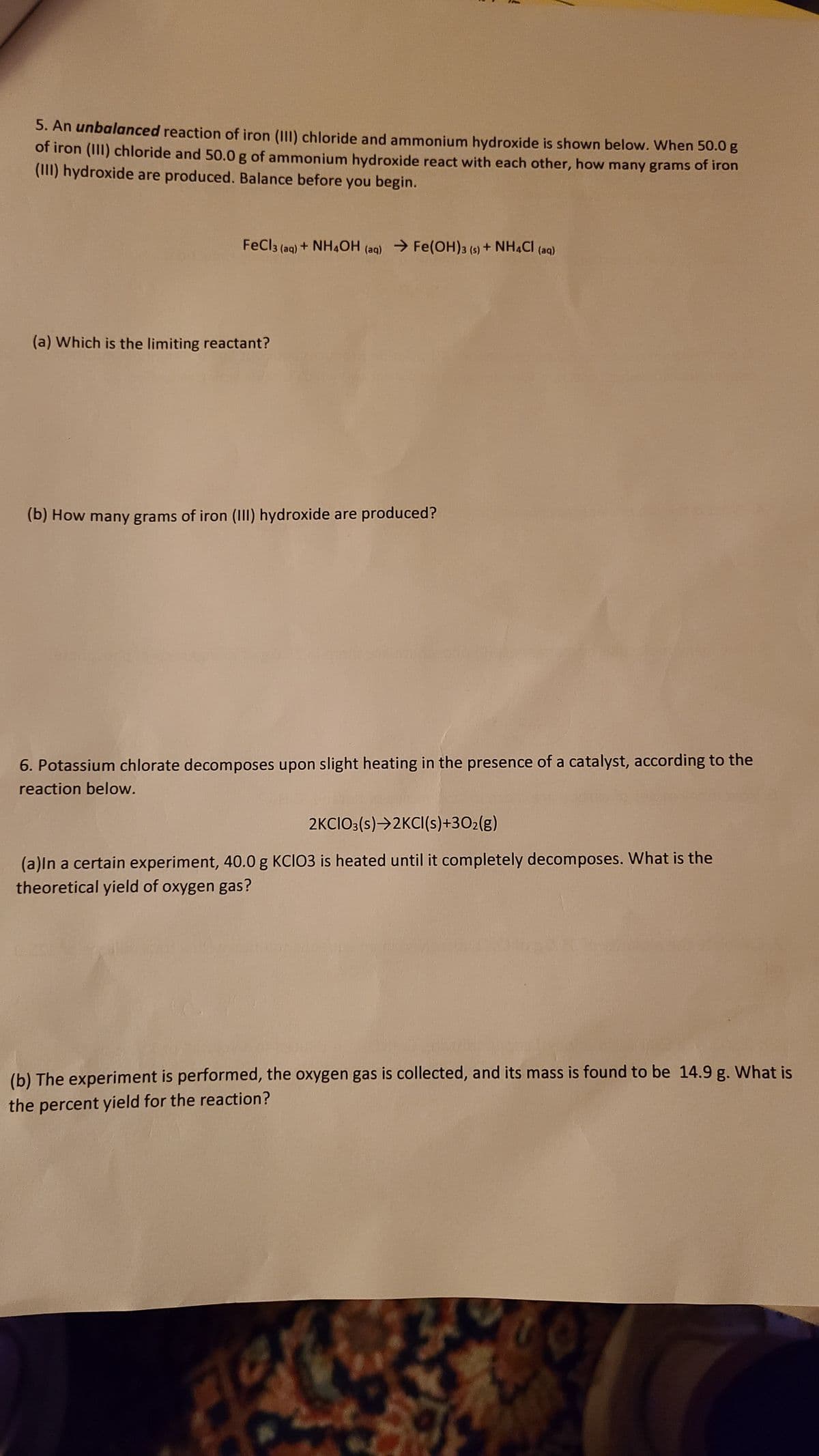5. An unbalanced reaction of iron (III) chloride and ammonium hydroxide is shown below. When 50.0 g of iron (III) chloride and 50.0 g of ammonium hydroxide react with each other, how many grams of iron (III) hydroxide are produced. Balance before you begin. FeCl3 (aq) + NH4OH (aq) → Fe(OH)3 (s) + NH4Cl (aq) (a) Which is the limiting reactant? (b) How many grams of iron (III) hydroxide are produced? 6. Potassium chlorate decomposes upon slight heating in the presence of a catalyst, according to the reaction below. 2KCIO3(s)→2KCI(s)+302(g) (a)In a certain experiment, 40.0 g KCIO3 is heated until it completely decomposes. What is the theoretical yield of oxygen gas? (b) The experiment is performed, the oxygen gas is collected, and its mass is found to be 14.9 g. What is the percent yield for the reaction?
5. An unbalanced reaction of iron (III) chloride and ammonium hydroxide is shown below. When 50.0 g of iron (III) chloride and 50.0 g of ammonium hydroxide react with each other, how many grams of iron (III) hydroxide are produced. Balance before you begin. FeCl3 (aq) + NH4OH (aq) → Fe(OH)3 (s) + NH4Cl (aq) (a) Which is the limiting reactant? (b) How many grams of iron (III) hydroxide are produced? 6. Potassium chlorate decomposes upon slight heating in the presence of a catalyst, according to the reaction below. 2KCIO3(s)→2KCI(s)+302(g) (a)In a certain experiment, 40.0 g KCIO3 is heated until it completely decomposes. What is the theoretical yield of oxygen gas? (b) The experiment is performed, the oxygen gas is collected, and its mass is found to be 14.9 g. What is the percent yield for the reaction?
General Chemistry - Standalone book (MindTap Course List)
11th Edition
ISBN:9781305580343
Author:Steven D. Gammon, Ebbing, Darrell Ebbing, Steven D., Darrell; Gammon, Darrell Ebbing; Steven D. Gammon, Darrell D.; Gammon, Ebbing; Steven D. Gammon; Darrell
Publisher:Steven D. Gammon, Ebbing, Darrell Ebbing, Steven D., Darrell; Gammon, Darrell Ebbing; Steven D. Gammon, Darrell D.; Gammon, Ebbing; Steven D. Gammon; Darrell
Chapter3: Calculations With Chemical Formulas And Equaitons
Section: Chapter Questions
Problem 3.106QP: A titanium ore contains rutile (TiO2) plus some iron oxide and silica. When it is heated with carbon...
Related questions
Question

Transcribed Image Text:5. An unbalanced reaction of iron (III) chloride and ammonium hydroxide is shown below. When 50.0 g
of iron (III) chloride and 50.0 g of ammonium hydroxide react with each other, how many grams of iron
(III) hydroxide are produced. Balance before you begin.
FeCl3 (aq) + NH4OH (aq) → Fe(OH)3 (s) + NH4Cl (aq)
(a) Which is the limiting reactant?
(b) How many grams of iron (III) hydroxide are produced?
6. Potassium chlorate decomposes upon slight heating in the presence of a catalyst, according to the
reaction below.
2KCIO3(s)→2KCI(s)+30₂(g)
(a)In a certain experiment, 40.0 g KCIO3 is heated until it completely decomposes. What is the
theoretical yield of oxygen gas?
(b) The experiment is performed, the oxygen gas is collected, and its mass is found to be 14.9 g. What is
the percent yield for the reaction?
Expert Solution
This question has been solved!
Explore an expertly crafted, step-by-step solution for a thorough understanding of key concepts.
This is a popular solution!
Trending now
This is a popular solution!
Step by step
Solved in 4 steps with 3 images

Knowledge Booster
Learn more about
Need a deep-dive on the concept behind this application? Look no further. Learn more about this topic, chemistry and related others by exploring similar questions and additional content below.Recommended textbooks for you

General Chemistry - Standalone book (MindTap Cour…
Chemistry
ISBN:
9781305580343
Author:
Steven D. Gammon, Ebbing, Darrell Ebbing, Steven D., Darrell; Gammon, Darrell Ebbing; Steven D. Gammon, Darrell D.; Gammon, Ebbing; Steven D. Gammon; Darrell
Publisher:
Cengage Learning

Chemistry for Engineering Students
Chemistry
ISBN:
9781337398909
Author:
Lawrence S. Brown, Tom Holme
Publisher:
Cengage Learning

Chemistry & Chemical Reactivity
Chemistry
ISBN:
9781337399074
Author:
John C. Kotz, Paul M. Treichel, John Townsend, David Treichel
Publisher:
Cengage Learning

General Chemistry - Standalone book (MindTap Cour…
Chemistry
ISBN:
9781305580343
Author:
Steven D. Gammon, Ebbing, Darrell Ebbing, Steven D., Darrell; Gammon, Darrell Ebbing; Steven D. Gammon, Darrell D.; Gammon, Ebbing; Steven D. Gammon; Darrell
Publisher:
Cengage Learning

Chemistry for Engineering Students
Chemistry
ISBN:
9781337398909
Author:
Lawrence S. Brown, Tom Holme
Publisher:
Cengage Learning

Chemistry & Chemical Reactivity
Chemistry
ISBN:
9781337399074
Author:
John C. Kotz, Paul M. Treichel, John Townsend, David Treichel
Publisher:
Cengage Learning

Chemistry & Chemical Reactivity
Chemistry
ISBN:
9781133949640
Author:
John C. Kotz, Paul M. Treichel, John Townsend, David Treichel
Publisher:
Cengage Learning

Chemistry: The Molecular Science
Chemistry
ISBN:
9781285199047
Author:
John W. Moore, Conrad L. Stanitski
Publisher:
Cengage Learning

General, Organic, and Biological Chemistry
Chemistry
ISBN:
9781285853918
Author:
H. Stephen Stoker
Publisher:
Cengage Learning